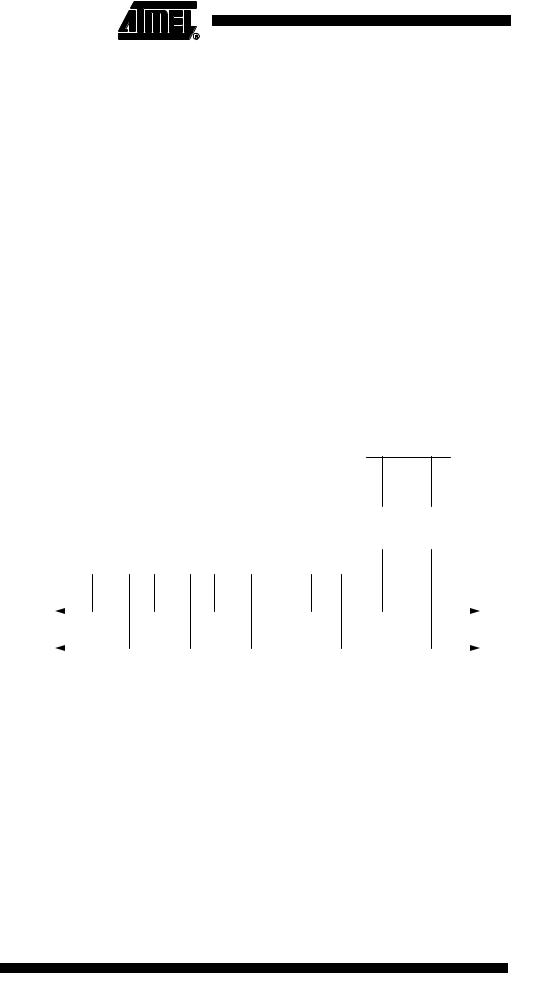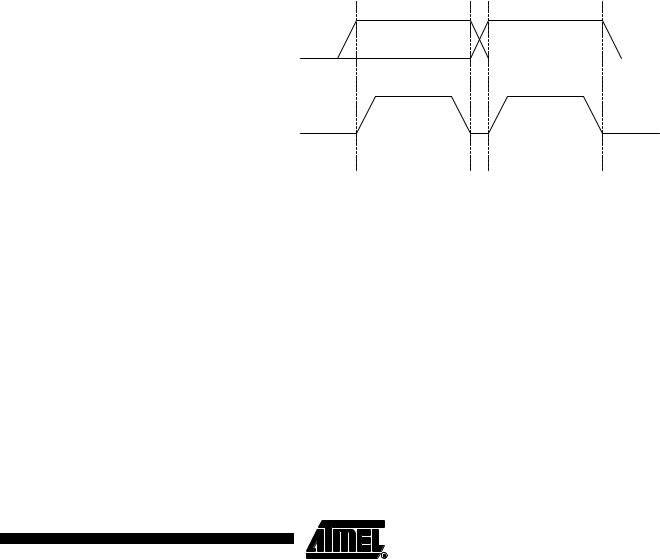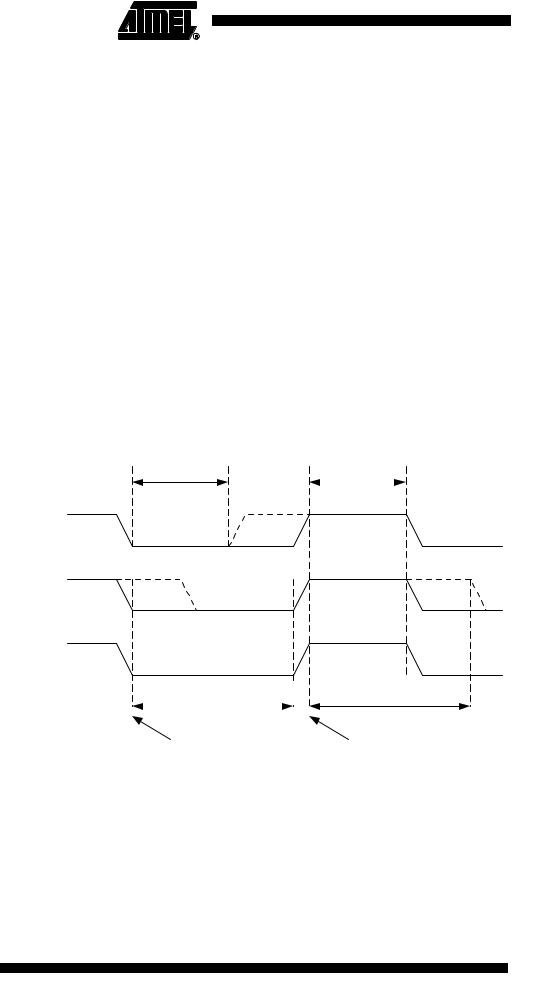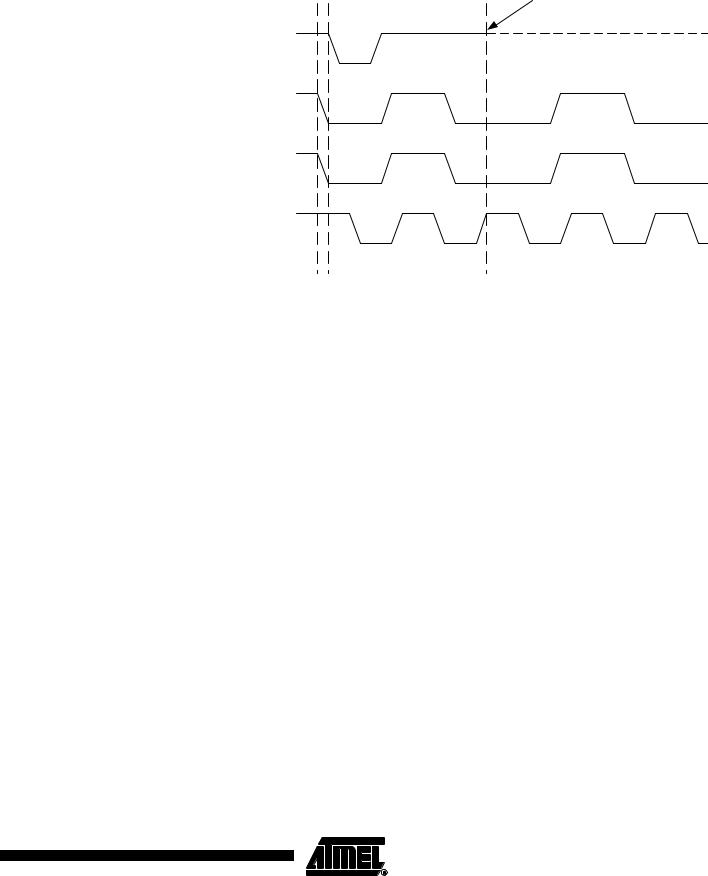
- •Features
- •Pin Configurations
- •Overview
- •Block Diagram
- •Disclaimer
- •Pin Descriptions
- •Port C (PC5..PC0)
- •PC6/RESET
- •Port D (PD7..PD0)
- •RESET
- •AVCC
- •AREF
- •AVR CPU Core
- •Introduction
- •Architectural Overview
- •Status Register
- •Stack Pointer
- •Interrupt Response Time
- •SRAM Data Memory
- •EEPROM Data Memory
- •EEPROM Read/Write Access
- •I/O Memory
- •Clock Systems and their Distribution
- •Clock Sources
- •Crystal Oscillator
- •External RC Oscillator
- •External Clock
- •Timer/Counter Oscillator
- •Idle Mode
- •Power-down Mode
- •Power-save Mode
- •Standby Mode
- •Analog Comparator
- •Brown-out Detector
- •Internal Voltage Reference
- •Watchdog Timer
- •Port Pins
- •Resetting the AVR
- •Reset Sources
- •Power-on Reset
- •External Reset
- •Brown-out Detection
- •Watchdog Reset
- •Watchdog Timer
- •Timed Sequences for Changing the Configuration of the Watchdog Timer
- •Interrupts
- •I/O Ports
- •Introduction
- •Configuring the Pin
- •Reading the Pin Value
- •Unconnected pins
- •Alternate Port Functions
- •Alternate Functions of Port B
- •Alternate Functions of Port C
- •Alternate Functions of Port D
- •Register Description for I/O Ports
- •External Interrupts
- •8-bit Timer/Counter0
- •Overview
- •Registers
- •Definitions
- •Counter Unit
- •Operation
- •Internal Clock Source
- •Prescaler Reset
- •External Clock Source
- •16-bit Timer/Counter1
- •Overview
- •Registers
- •Definitions
- •Compatibility
- •Counter Unit
- •Input Capture Unit
- •Input Capture Pin Source
- •Noise Canceler
- •Using the Input Capture Unit
- •Output Compare Units
- •Force Output Compare
- •Modes of Operation
- •Normal Mode
- •Fast PWM Mode
- •Phase Correct PWM Mode
- •8-bit Timer/Counter2 with PWM and Asynchronous Operation
- •Overview
- •Registers
- •Definitions
- •Counter Unit
- •Output Compare Unit
- •Force Output Compare
- •Modes of Operation
- •Normal Mode
- •Fast PWM Mode
- •Phase Correct PWM Mode
- •Timer/Counter Prescaler
- •SS Pin Functionality
- •Slave Mode
- •Master Mode
- •Data Modes
- •USART
- •Overview
- •Clock Generation
- •External Clock
- •Synchronous Clock Operation
- •Frame Formats
- •Parity Bit Calculation
- •USART Initialization
- •Sending Frames with 5 to 8 Data Bits
- •Sending Frames with 9 Data Bits
- •Parity Generator
- •Disabling the Transmitter
- •Receiving Frames with 5 to 8 Data Bits
- •Receiving Frames with 9 Data Bits
- •Receiver Error Flags
- •Parity Checker
- •Disabling the Receiver
- •Flushing the Receive Buffer
- •Asynchronous Data Recovery
- •Using MPCM
- •Write Access
- •Read Access
- •Two-wire Serial Interface
- •Features
- •TWI Terminology
- •Electrical Interconnection
- •Transferring Bits
- •START and STOP Conditions
- •Address Packet Format
- •Data Packet Format
- •Overview of the TWI Module
- •SCL and SDA Pins
- •Bit Rate Generator Unit
- •Bus Interface Unit
- •Address Match Unit
- •Control Unit
- •TWI Register Description
- •Using the TWI
- •Transmission Modes
- •Master Transmitter Mode
- •Master Receiver Mode
- •Slave Receiver Mode
- •Slave Transmitter Mode
- •Miscellaneous States
- •Analog Comparator
- •Analog Comparator Multiplexed Input
- •Features
- •Starting a Conversion
- •Changing Channel or Reference Selection
- •ADC Input Channels
- •ADC Voltage Reference
- •ADC Noise Canceler
- •Analog Input Circuitry
- •ADC Accuracy Definitions
- •ADC Conversion Result
- •ADLAR = 0
- •ADLAR = 1
- •Boot Loader Features
- •Application Section
- •Boot Loader Lock Bits
- •Performing a Page Write
- •Using the SPM Interrupt
- •Setting the Boot Loader Lock Bits by SPM
- •Reading the Fuse and Lock Bits from Software
- •Preventing Flash Corruption
- •Simple Assembly Code Example for a Boot Loader
- •Fuse Bits
- •Latching of Fuses
- •Signature Bytes
- •Calibration Byte
- •Page Size
- •Signal Names
- •Parallel Programming
- •Enter Programming Mode
- •Chip Erase
- •Programming the Flash
- •Programming the EEPROM
- •Reading the Flash
- •Reading the EEPROM
- •Programming the Lock Bits
- •Reading the Signature Bytes
- •Reading the Calibration Byte
- •Serial Downloading
- •Data Polling Flash
- •Data Polling EEPROM
- •Electrical Characteristics
- •Absolute Maximum Ratings*
- •DC Characteristics
- •External Clock Drive Waveforms
- •External Clock Drive
- •Two-wire Serial Interface Characteristics
- •ADC Characteristics
- •Active Supply Current
- •Idle Supply Current
- •Power-down Supply Current
- •Power-save Supply Current
- •Standby Supply Current
- •Pin Pull-up
- •Pin Driver Strength
- •Internal Oscillator Speed
- •Register Summary
- •Instruction Set Summary
- •Ordering Information
- •Packaging Information
- •Erratas
- •Changes from Rev. 2486N-09/04 to Rev. 2486O-10/04
- •Changes from Rev. 2486M-12/03 to Rev. 2486N-09/04
- •Changes from Rev. 2486L-10/03 to Rev. 2486M-12/03
- •Changes from Rev. 2486K-08/03 to Rev. 2486L-10/03
- •Changes from Rev. 2486J-02/03 to Rev. 2486K-08/03
- •Changes from Rev. 2486I-12/02 to Rev. 2486J-02/03
- •Changes from Rev. 2486H-09/02 to Rev. 2486I-12/02
- •Changes from Rev. 2486G-09/02 to Rev. 2486H-09/02
- •Changes from Rev. 2486F-07/02 to Rev. 2486G-09/02
- •Changes from Rev. 2486E-06/02 to Rev. 2486F-07/02
- •Changes from Rev. 2486D-03/02 to Rev. 2486E-06/02
- •Changes from Rev. 2486C-03/02 to Rev. 2486D-03/02
- •Changes from Rev. 2486B-12/01 to Rev. 2486C-03/02
- •Table of Contents

Two-wire Serial
Interface
Features
•Simple Yet Powerful and Flexible Communication Interface, only two Bus Lines Needed
•Both Master and Slave Operation Supported
•Device can Operate as Transmitter or Receiver
•7-bit Address Space Allows up to 128 Different Slave Addresses
•Multi-master Arbitration Support
•Up to 400 kHz Data Transfer Speed
•Slew-rate Limited Output Drivers
•Noise Suppression Circuitry Rejects Spikes on Bus Lines
•Fully Programmable Slave Address with General Call Support
•Address Recognition Causes Wake-up When AVR is in Sleep Mode
Two-wire Serial Interface
Bus Definition
The Two-wire Serial Interface (TWI) is ideally suited for typical microcontroller applications. The TWI protocol allows the systems designer to interconnect up to 128 different devices using only two bi-directional bus lines, one for clock (SCL) and one for data (SDA). The only external hardware needed to implement the bus is a single pull-up resistor for each of the TWI bus lines. All devices connected to the bus have individual addresses, and mechanisms for resolving bus contention are inherent in the TWI protocol.
Figure 68. TWI Bus Interconnection
VCC
Device 1 |
|
|
|
Device 3 |
|
|
|
|
|
|
|
Device 2 |
|
........ |
Device n |
|
R1 |
|
R2 |
||
|
|
|
|
|
|
|
|
|
|
|
|
|
|
|
|
|
|
|
|
|
|
|
SDA |
|
|
|
|
|
|
|
|
TWI Terminology |
SCL |
|
|
|
|
|
|
||
The following definitions are frequently encountered in this section. |
|
|||
|
Table 64. TWI Terminology |
|
||
|
|
|
|
|
|
Term |
|
Description |
|
|
|
|
|
|
|
Master |
|
The device that initiates and terminates a transmission. The Master also |
|
|
|
|
generates the SCL clock. |
|
|
|
|
|
|
|
Slave |
|
The device addressed by a Master. |
|
|
|
|
|
|
|
Transmitter |
|
The device placing data on the bus. |
|
|
|
|
|
|
|
Receiver |
|
The device reading data from the bus. |
|
|
|
|
|
|
160 ATmega8(L)
2486O–AVR–10/04

|
|
|
|
ATmega8(L) |
|
|
|
|
|
||
|
Electrical Interconnection |
|
|
||
|
As depicted in Figure 68, both bus lines are connected to the positive supply voltage |
||||
|
|||||
|
|
through pull-up resistors. The bus drivers of all TWI-compliant devices are open-drain or |
|||
|
|
open-collector. This implements a wired-AND function which is essential to the opera- |
|||
|
|
tion of the interface. A low level on a TWI bus line is generated when one or more TWI |
|||
|
|
devices output a zero. A high level is output when all TWI devices tri-state their outputs, |
|||
|
|
allowing the pull-up resistors to pull the line high. Note that all AVR devices connected to |
|||
|
|
the TWI bus must be powered in order to allow any bus operation. |
|||
|
|
The number of devices that can be connected to the bus is only limited by the bus |
|||
|
|
capacitance limit of 400 pF and the 7-bit slave address space. A detailed specification of |
|||
|
|
the electrical characteristics of the TWI is given in “Two-wire Serial Interface Character- |
|||
|
|
istics” on page 242. Two different sets of specifications are presented there, one |
|||
|
|
relevant for bus speeds below 100 kHz, and one valid for bus speeds up to 400 kHz. |
|||
|
Data Transfer and Frame |
|
|
|
|
|
Format |
|
|
|
|
|
Transferring Bits |
Each data bit transferred on the TWI bus is accompanied by a pulse on the clock line. |
|||
|
|
The level of the data line must be stable when the clock line is high. The only exception |
|||
|
|
to this rule is for generating start and stop conditions. |
|||
|
|
Figure 69. Data Validity |
|||
|
|
SDA |
|||
|
|
|
|
|
|
SCL
Data Stable |
Data Stable |
Data Change
START and STOP Conditions The Master initiates and terminates a data transmission. The transmission is initiated when the Master issues a START condition on the bus, and it is terminated when the Master issues a STOP condition. Between a START and a STOP condition, the bus is considered busy, and no other master should try to seize control of the bus. A special case occurs when a new START condition is issued between a START and STOP condition. This is referred to as a REPEATED START condition, and is used when the Master wishes to initiate a new transfer without relinquishing control of the bus. After a REPEATED START, the bus is considered busy until the next STOP. This is identical to the START behavior, and therefore START is used to describe both START and REPEATED START for the remainder of this datasheet, unless otherwise noted. As depicted below, START and STOP conditions are signalled by changing the level of the SDA line when the SCL line is high.
161
2486O–AVR–10/04

Figure 70. START, REPEATED START and STOP conditions
|
SDA |
|
|
|
|
SCL |
|
|
|
|
START |
STOP START |
REPEATED START |
STOP |
Address Packet Format |
All address packets transmitted on the TWI bus are 9 bits long, consisting of 7 address |
|||
|
bits, one READ/WRITE control bit and an acknowledge bit. If the READ/WRITE bit is |
|||
|
set, a read operation is to be performed, otherwise a write operation should be per- |
|||
|
formed. When a Slave recognizes that it is being addressed, it should acknowledge by |
|||
pulling SDA low in the ninth SCL (ACK) cycle. If the addressed Slave is busy, or for some other reason can not service the Master’s request, the SDA line should be left high in the ACK clock cycle. The Master can then transmit a STOP condition, or a REPEATED START condition to initiate a new transmission. An address packet consisting of a slave address and a READ or a WRITE bit is called SLA+R or SLA+W, respectively.
The MSB of the address byte is transmitted first. Slave addresses can freely be allocated by the designer, but the address 0000 000 is reserved for a general call.
When a general call is issued, all slaves should respond by pulling the SDA line low in the ACK cycle. A general call is used when a Master wishes to transmit the same message to several slaves in the system. When the general call address followed by a Write bit is transmitted on the bus, all slaves set up to acknowledge the general call will pull the SDA line low in the ack cycle. The following data packets will then be received by all the slaves that acknowledged the general call. Note that transmitting the general call address followed by a Read bit is meaningless, as this would cause contention if several slaves started transmitting different data.
All addresses of the format 1111 xxx should be reserved for future purposes.
Figure 71. Address Packet Format
Addr MSB |
|
Addr LSB R/W |
ACK |
|
|
|
|
SDA
SCL
1 |
2 |
7 |
8 |
9 |
START
162 ATmega8(L)
2486O–AVR–10/04

|
|
|
ATmega8(L) |
|
|
|
|
|
Data Packet Format |
|
|
|
All data packets transmitted on the TWI bus are nine bits long, consisting of one data |
||
|
|||
|
|
byte and an acknowledge bit. During a data transfer, the Master generates the clock and |
|
|
|
the START and STOP conditions, while the Receiver is responsible for acknowledging |
|
|
|
the reception. An Acknowledge (ACK) is signalled by the Receiver pulling the SDA line |
|
|
|
low during the ninth SCL cycle. If the Receiver leaves the SDA line high, a NACK is sig- |
|
|
|
nalled. When the Receiver has received the last byte, or for some reason cannot receive |
|
|
|
any more bytes, it should inform the Transmitter by sending a NACK after the final byte. |
|
|
|
The MSB of the data byte is transmitted first. |
|
|
|
Figure 72. Data Packet Format |
|
Data MSB Data LSB ACK
Aggregate
SDA
SDA from
Transmitter
SDA from
Receiver
SCL from
Master
1 |
2 |
7 |
8 |
9 |
STOP, REPEATED |
|
|
|
|
|
|
SLA+R/W |
|
Data Byte |
|
|
START or Next |
|
|
|
|
|
Data Byte |
Combining Address and Data A transmission basically consists of a START condition, a SLA+R/W, one or more data Packets into a Transmission packets and a STOP condition. An empty message, consisting of a START followed by a STOP condition, is illegal. Note that the Wired-ANDing of the SCL line can be used to implement handshaking between the Master and the Slave. The Slave can extend the SCL low period by pulling the SCL line low. This is useful if the clock speed set up by the Master is too fast for the Slave, or the Slave needs extra time for processing between the data transmissions. The Slave extending the SCL low period will not affect the SCL high period, which is determined by the Master. As a consequence, the Slave can
reduce the TWI data transfer speed by prolonging the SCL duty cycle.
Figure 73 shows a typical data transmission. Note that several data bytes can be transmitted between the SLA+R/W and the STOP condition, depending on the software protocol implemented by the application software.
Figure 73. Typical Data Transmission
Addr MSB |
|
Addr LSB R/W |
ACK |
Data MSB |
|
Data LSB ACK |
|
|
|
|
|
|
|
SDA
SCL
1 |
2 |
7 |
8 |
9 |
1 |
2 |
7 |
8 |
9 |
START |
|
SLA+R/W |
|
|
|
Data Byte |
|
|
STOP |
163
2486O–AVR–10/04

Multi-master Bus
Systems, Arbitration and
Synchronization
The TWI protocol allows bus systems with several masters. Special concerns have been taken in order to ensure that transmissions will proceed as normal, even if two or more masters initiate a transmission at the same time. Two problems arise in multi-mas- ter systems:
•An algorithm must be implemented allowing only one of the masters to complete the transmission. All other masters should cease transmission when they discover that they have lost the selection process. This selection process is called arbitration.
When a contending master discovers that it has lost the arbitration process, it should immediately switch to Slave mode to check whether it is being addressed by the winning master. The fact that multiple masters have started transmission at the same time should not be detectable to the slaves, i.e. the data being transferred on the bus must not be corrupted.
•Different masters may use different SCL frequencies. A scheme must be devised to synchronize the serial clocks from all masters, in order to let the transmission proceed in a lockstep fashion. This will facilitate the arbitration process.
The wired-ANDing of the bus lines is used to solve both these problems. The serial clocks from all masters will be wired-ANDed, yielding a combined clock with a high period equal to the one from the Master with the shortest high period. The low period of the combined clock is equal to the low period of the Master with the longest low period. Note that all masters listen to the SCL line, effectively starting to count their SCL high and low time-out periods when the combined SCL line goes high or low, respectively.
Figure 74. SCL Synchronization Between Multiple Masters
TA low |
TA high |
SCL from
Master A
SCL from
Master B
SCL Bus
Line
TBlow |
|
|
|
TBhigh |
|
||||
|
|
|||
|
|
|||
Masters Start |
Masters Start |
|||
Counting Low Period |
Counting High Period |
|||
Arbitration is carried out by all masters continuously monitoring the SDA line after outputting data. If the value read from the SDA line does not match the value the Master had output, it has lost the arbitration. Note that a Master can only lose arbitration when it outputs a high SDA value while another Master outputs a low value. The losing Master should immediately go to Slave mode, checking if it is being addressed by the winning Master. The SDA line should be left high, but losing masters are allowed to generate a clock signal until the end of the current data or address packet. Arbitration will continue until only one Master remains, and this may take many bits. If several masters are trying to address the same Slave, arbitration will continue into the data packet.
164 ATmega8(L)
2486O–AVR–10/04

 ATmega8(L)
ATmega8(L)
Figure 75. Arbitration Between Two Masters
START
SDA from
Master A
SDA from
Master B
SDA Line
Synchronized
SCL Line
Note that arbitration is not allowed between:
Master A Loses
Arbitration, SDAA SDA
SDA
•A REPEATED START condition and a data bit.
•A STOP condition and a data bit.
•A REPEATED START and a STOP condition.
It is the user software’s responsibility to ensure that these illegal arbitration conditions never occur. This implies that in multi-master systems, all data transfers must use the same composition of SLA+R/W and data packets. In other words: All transmissions must contain the same number of data packets, otherwise the result of the arbitration is undefined.
165
2486O–AVR–10/04
